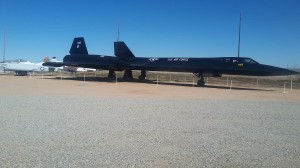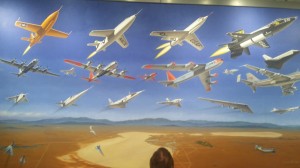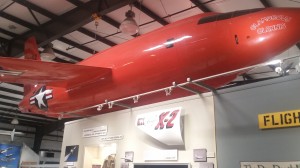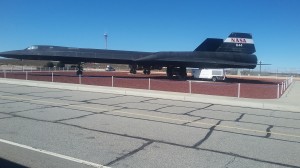EDWARDS AIR FORCE BASE
EDWARDS AIR FORCE BASE
By Charles N. Stevens
Photos by Dolores Seidman
It was a clear crisp February day for our trip to Edwards Air force base. It was also nice to get away from the city and look at new scenery. The views along Highway 14, on the way to Palmdale, were spectacular. The hills had greened with the recent rains and snow decked the San Bernardino Mountains in the distance. After passing through the hills, we were on the edge of the high desert, vast and flat, perfect for airports and the testing of experimental military aircraft.
At Rosamond we began the short drive to the main entrance of the base. After our bus was checked, we were transferred to another bus belonging to the base. The ride was rather bouncy but tolerable.
Our first stop was for lunch at the Armstrong NASA facility named for astronaut Neil Armstrong who trained at this base, where a small food court offered sandwiches and grilled items for sale.
Once fed, we scrambled onto our rickety bus. Where we boarded the bus was an SR-71 Blackbird, a sleek black wonder that was our chief spy plane for many years. The plane which holds the world speed record is also a beautiful craft to look at. Our bus pulled away for a tour of the facilities at Edwards. It is quite a scene to see the vast flatness of Rogers Dry Lake and the sand-colored hangers of the base. In front of us, far away and to the south were the snow-clad San Bernardino Mountains and to the north the equally snowy Tehachapi Mountains. Our guide gave us some information about some of the hangars and buildings we were seeing, but others were so secret, he could not talk about them. Taking photographs was forbidden.
As our bus took us along the flight line, we were lucky to catch a glimpse of the B-2 bomber being pushed into one of the hangars. The stealth bomber looked like a great gray bat as it eased into the darkness of the hangar. This was the plane that flies over the Rose Parade and thrills the crowd every year.
We drove by a whole squadron of F-18 fighter planes poised on the tarmac. They were here temporarily for some type of exercise. The twin-tailed, pointed nose F-18 Hornet has a top speed of 1,190 miles per hour and has a price tag of 29 million dollars. We also saw several new F-35s nestled under curved roofs. The F-35 Lightning II is produced by Lockheed-Martin. The F-35 has also been delivered to the Dutch Air Force. We also passed the planes of the test pilot school where young men and women learn the risky job of testing planes that may or may not perform the way anticipated.
We were also lucky to see several KC-35 air tankers, used to refuel other planes while in flight. We could see the winged nozzle of the fuel hose protruding from the rear of the planes.
After visiting the flight line, we were transported to the Base Museum where the history of the base was clearly shown. Outside the museum building were many of the planes once tested at Edward’s, including the SR-71 Blackbird. Inside, there were two complete planes. One was the Bell X-2, a bright orange bullet shaped plane tested at Edwards. Released by a B-29 at high altitude, it sped faster than the speed of sound thereby generating a sonic boom. The other plane was an F-22 Raptor, a supersonic fighter plane. Painted a dull gray it looked massive and incapable of reaching such speeds.
A superb display of models attached to a wall demonstrated the types of planes tested over the years. Equipment is on display and movies point out the importance of Edwards Air Force Base.
I think we all came away thinking that our Air Force was first rate and that many more planes would be tested and added to the strength of our nation.

The SR-71 Blackbird was once the U.S. chief spy plane.

A mural in the Edwards Air Force Museum depicts the planes tested at the base.

The famous Bell X-1 is now displayed in the Edwards Museum.

Another view of the SR-71 holder of the world's speed record.
MONTEREY PARK AUTHOR PUBLISHES 4th BOOK – Seeking More of the Sky: Growing Up in the 1930’s:
Charles “Norm” Stevens, a 43 year resident of Monterey Park has recently published his 4th book: Seeking More of the Sky: Growing Up in the 1930’s. This is the story of a young boy growing up in Inglewood, California in the l930’s. This was a time during the depression when unemployment was affecting many and the banks were closed, while the clouds of war were gathering in Europe. But he was lucky enough to be raised in a loving family, the power of that love reflected throughout his stories.
Stevens is the author of three previous books about his experiences during WWII:
An Innocent at Polebrook: A Memoir of an 8th Air Force Bombardier (Story of his 34 bombing missions from his base at Polebrook, England over Germany and France)
The Innocent Cadet: Becoming A World War II Bombardier (A prequel to the first, telling of his training in the U.S. before going overseas into combat.)
Back from Combat: A WWII Bombardier Faces His Military Future from Combat: (This book details the time from when he returned from combat in England until the end of the war.)
He is known to the readers of The Citizen’s Voice as the author of Travel Log Articles including “Cruising the Rhine and Mosel”,” Best of the West”, “In Search of Snow” , “From Paris to Normandy on the Seine”, and “Exploring New York”. He is retired, having taught for 32 years, primarily in the Montebello Unified School District.
Those interested in purchasing an autographed copy of any of his books, may contact the author at 323-721-8230 or Normstevens24@gmail.com.



